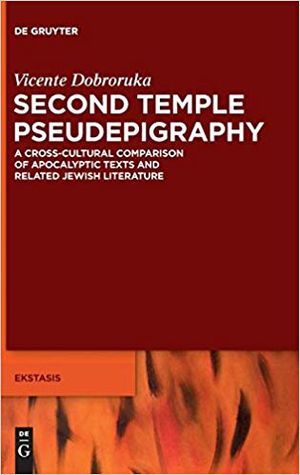Second Temple Pseudepigraphy: A Cross-Cultural Comparison of Apocalyptic Texts and Related Jewish Literature (2014 Dobroruka), book
Second Temple Pseudepigraphy: A Cross-Cultural Comparison of Apocalyptic Texts and Related Jewish Literature (2014) is a book by Vicente Dobroruka.
Abstract
"At this point of the scholarly debate on the nature of Second Temple pseudepigraphy, one may ask why another look at the problem is needed. This book is not the definitive answer to that problem but it proposes different paths - or better still, a two-fold path: on one hand to understand Second Temple pseudepigraphy as a mystical experience and on the other, for lack of a suitable ancient example, to compare it to modern-day automatic writing."--Publisher description.
Editions
Published in New York, NY: Thomas Dunne Books, St. Martin's Press, 2014.
Contents
Introduction; Chapter 1 -- Why a cross-cultural approach is needed in order to try a different understanding of Second Temple pseudepigraphy; 1 Introductory remarks; 2 Nature and purpose of cross-cultural studies in Biblical scholarship; 3 Terminology and definitions; 3.1 Altered states of consciousness; 3.2 Ecstasy; 3.3 Possession; 3.4 Automatisms; 3.5 Hypnosis; 4 Automatic writing and ecstatic practices in recent scholarship; 5 The meaning of pseudepigraphy; 6 Outline of scholarship about late Second Temple apocalyptic pseudepigraphy.; 6.1 The concept of corporate identity as applied to apocalyptic pseudepigraphy6.2 Recent discussions on apocalyptic pseudepigraphy regarding identification with alleged author; Chapter 2 -- How much is automatic writing useful as a hermeneutic tool?; 1 Automatic writing as hypnotic phenomenon; 1.1 Non-mystical automatic writing; 1.2 Writings in other languages; 2 Multiple-personality phenomena and automatic writing; 3 Automatic writing as possession; 4 Past-lives therapy, hypnosis and identity with past characters; 5 Summary; Chapter 3 -- Automatic writing in modern-day Kardecism.; 1 Introductory remarks to the chapter2 Brief introduction to the development of Brazilian Kardecism; 2.1 A survey of Kardecist doctrine; 2.2 Kardecism in Brazil; 3 Kardecist preparatory processes for automatic writing; 3.1 Automatic writing and mediumship training; 3.2 Preparation and meaning of automatic writing in Brazilian Kardecism; 3.3 Genre and personal identity of the spiritual author; 4 Editorial mediation of psychography; 5 Two modern-day Kardecist apocalypses, and how their alleged authors are portrayed; 6 Summary; Chapter 4 -- Automatic writing in Antiquity regarding religious texts.; 1 Introductory remarks to the chapter2 Survey of chosen passages; 2.1 Full description of the narrator's identity; 2.2 Other descriptions of the narrator's identity; 2.3 Passages with smaller number of indications; 3 Authorship of apocalyptic texts and divine manifestations; 3.1 Brief discussion; 3.2 Divine interference manifest in the texts; 4 Possible evidence for automatic writing in three specific ancient cases; 4.1 Writings from a deceased prophet via human hands: the case of 2Chr 21; 4.2 Texts handed down directly from above: the Book of Elchasai.; 4.3 Fraud and satire: written instructions for the Greek credulous5 Summary; Chapter 5 -- Philo, Josephus and 4Ezra: the main testimonies for inspired writing during the Second Temple Period; 1 Introductory remarks to the chapter; 2 Survey of chosen passages; 2.1 Philo of Alexandria; 2.2 Josephus; 2.3 4Ezra; 3 Issues at stake in cross-cultural comparison regarding the three authors; 3.1 Knowledge and scholarship as essential issues; 3.2 More sophisticated devices in terms of preparation versus rationalizing; 4 Summary; Chapter 6 -- Considerations on religious pseudepigraphy in Antiquity.
